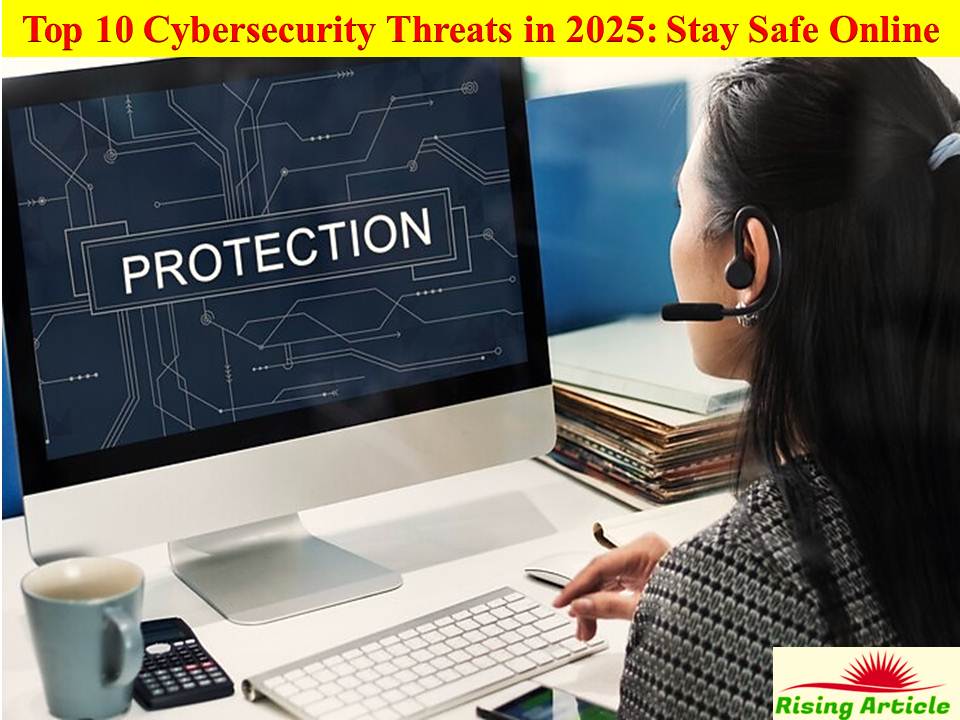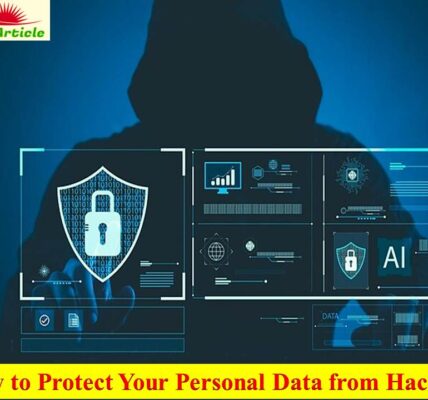The Growing Need for Cybersecurity in 2025 🌐🔒
As we head into 2025, the digital landscape continues to evolve, and with it, the threats to cybersecurity become more sophisticated. Hackers are constantly finding new methods to exploit vulnerabilities in software, networks, and personal devices.
Cybersecurity threats are no longer just the concern of large corporations or government organizations; individuals and small businesses are now prime targets for cybercriminals. Whether it’s your personal data, financial information, or online privacy that’s at risk, understanding the latest threats and knowing how to protect yourself is vital.
In this article, we’ll explore the top 10 cybersecurity threats in 2025 and provide you with essential tips to stay secure in an increasingly connected world. Let’s dive in! 🚀
 📊 Top 10 Cybersecurity Threats in 2025: Quick Overview
📊 Top 10 Cybersecurity Threats in 2025: Quick Overview
| Threat | Description |
| 1. Phishing Attacks | Fraudulent attempts to steal sensitive information. |
| 2. Ransomware | Malicious software that demands payment to restore data. |
| 3. AI-Driven Attacks | Cyberattacks powered by artificial intelligence. |
| 4. Internet of Things (IoT) Vulnerabilities | Security issues in connected devices. |
| 5. Deepfake Technology | Manipulated media used for fraud or misinformation. |
| 6. Cloud Security Risks | Vulnerabilities in cloud-based systems and storage. |
| 7. Social Engineering | Psychological manipulation to gain confidential information. |
| 8. Data Breaches | Unauthorized access to private data. |
| 9. Insider Threats | Security risks caused by employees or trusted individuals. |
| 10. 5G Network Exploits | Potential vulnerabilities in 5G technology. |
🚀 Conclusion: As we approach 2025, it’s important to stay ahead of these emerging cybersecurity threats. Let’s explore each of these threats in detail and understand how they can impact your digital life.
️⃣ Phishing Attacks: The Most Common Cybersecurity Threat 📨🚨
Phishing remains one of the most common and effective forms of cyberattacks in 2025. Phishing is when cybercriminals impersonate legitimate organizations to trick users into revealing sensitive information such as passwords, credit card details, or personal information.
✅ How to Protect Yourself from Phishing Attacks:
✔️ Be cautious of unsolicited emails or messages asking for personal information.
✔️ Verify links before clicking on them by hovering over the URL.
✔️ Use multi-factor authentication (MFA) for added security on your accounts.
✔️ Educate yourself and your team about common phishing tactics.
💡 Best For: Protecting personal accounts, email, and online banking.
️⃣ Ransomware: Malicious Software Demanding Payment 💻💰
Ransomware continues to be a serious threat in 2025. This type of malware locks or encrypts your files and demands a ransom (usually in cryptocurrency) to release them. Attacks can happen to individuals, businesses, and even governments.
✅ How to Defend Against Ransomware:
✔️ Backup your data regularly to an offline or cloud-based storage.
✔️ Use reliable security software and firewalls to block malware.
✔️ Don’t pay the ransom – paying does not guarantee that your files will be restored.
💡 Best For: Protecting critical data and business networks.
️⃣ AI-Driven Attacks: Cybersecurity in the Age of Artificial Intelligence 🤖🧠
As artificial intelligence (AI) continues to advance, so do the tools used by cybercriminals. AI-powered cyberattacks are becoming more sophisticated and harder to detect. These attacks use machine learning to analyze and target vulnerabilities in systems, often outsmarting traditional security protocols.
✅ How to Stay Safe from AI-Driven Attacks:
✔️ Use advanced security systems that employ AI for proactive defense.
✔️ Regularly update your software to patch AI-exploitable vulnerabilities.
✔️ Implement AI-based threat detection tools to identify unusual behavior.
💡 Best For: Corporate networks and advanced digital environments.
️⃣ IoT Vulnerabilities: The Risk of Connected Devices 🌐🔒
The Internet of Things (IoT) has brought convenience and efficiency to our lives. However, connected devices like smart TVs, security cameras, and home assistants present a growing cybersecurity risk. Many IoT devices have weak security protocols, making them vulnerable to hacking.
✅ How to Protect Your IoT Devices:
✔️ Change default passwords on all IoT devices.
✔️ Update device firmware regularly.
✔️ Use network segmentation to isolate IoT devices from your main network.
💡 Best For: Protecting smart home devices and connected gadgets.
️⃣ Deepfake Technology: Manipulated Media for Misinformation 🎬🔍
Deepfakes are AI-generated videos, audio, or images that manipulate media to make it appear as if someone said or did something they didn’t. This technology is being used for fraud, identity theft, and even misleading the public.
✅ How to Avoid Falling for Deepfakes:
✔️ Verify the source of video or audio content before trusting it.
✔️ Use deepfake detection tools to analyze suspicious media.
✔️ Stay informed about the latest developments in deepfake technology.
💡 Best For: Journalists, political leaders, and anyone vulnerable to misinformation.
️⃣ Cloud Security Risks: Data Vulnerabilities in the Cloud ☁️🔓
As more businesses move their data to the cloud, the risk of cloud-based security breaches increases. Misconfigurations, weak access controls, and poor security practices can leave sensitive information exposed.
✅ How to Secure Your Cloud Storage:
✔️ Use strong authentication methods, such as multi-factor authentication (MFA).
✔️ Encrypt sensitive data before storing it in the cloud.
✔️ Choose a reputable cloud service provider with robust security features.
💡 Best For: Businesses and individuals using cloud storage for sensitive data.
️⃣ Social Engineering: Psychological Manipulation for Data Theft 🧠💻
Social engineering is when attackers manipulate individuals into disclosing confidential information. Unlike technical attacks, social engineering relies on psychological manipulation and human error.
✅ How to Prevent Social Engineering:
✔️ Educate yourself and your team on common social engineering tactics.
✔️ Verify requests for sensitive information by using a separate communication method.
✔️ Be cautious of unsolicited requests via phone, email, or social media.
💡 Best For: Business owners, employees, and individuals who deal with sensitive information.
️⃣ Data Breaches: Unauthorized Access to Sensitive Information 🔓💼
Data breaches occur when cybercriminals gain unauthorized access to sensitive information, such as personal identification or financial records. These breaches are becoming more frequent as attackers target large organizations or companies with poor security.
✅ How to Avoid Data Breaches:
✔️ Encrypt sensitive data both in transit and at rest.
✔️ Monitor your systems regularly for any suspicious activity.
✔️ Train employees on proper data handling and protection practices.
💡 Best For: Businesses and organizations that store large amounts of sensitive data.
️⃣ Insider Threats: Security Risks from Within 👥💼
Insider threats come from employees or trusted individuals who either intentionally or accidentally compromise security. These threats can include data theft, sabotage, or unauthorized access to systems.
✅ How to Prevent Insider Threats:
✔️ Implement strict access controls to limit the information employees can access.
✔️ Monitor user activity for signs of malicious behavior.
✔️ Conduct regular employee training on security best practices.
💡 Best For: Large organizations with employees accessing sensitive data.
5G Network Exploits: Vulnerabilities in Next-Gen Connectivity 📶⚠️
As 5G networks expand, so do the security risks associated with them. Hackers may exploit vulnerabilities in 5G technology to disrupt communications, access data, or launch cyberattacks.
✅ How to Secure Your 5G Connection:
✔️ Monitor your network for vulnerabilities and patch security holes.
✔️ Use end-to-end encryption for data transmitted over the 5G network.
✔️ Ensure your devices are 5G-compatible and secure.
💡 Best For: Businesses and individuals using 5G-enabled devices.
📢 Conclusion: Protect Your Data from 2025’s Top Cybersecurity Threats 🔐🌍
As cybersecurity threats evolve in 2025, it’s crucial to stay informed and proactive in protecting your personal and business data. By following these top 10 tips, you can better safeguard your information and minimize the risk of falling victim to cyberattacks.
💡 Stay vigilant, implement strong security measures, and always be prepared to adapt to the changing cybersecurity landscape.
Read More Article:-
- How to Protect Your Personal Data from Hackers: Essential Tips for 2025 🔐🛡️
- The Best Free Antivirus Software for Your PC in 2025: Top Picks for Protection 🛡️💻
- Password Managers: Are They Really Safe? 🔒🛡️
- The Best Noise-Canceling Headphones of 2025: Top Picks for Ultimate Sound Quality 🎧🔊
- Google Pixel 9: Features, Price & Release Date – Everything You Need to Know 📱💡




